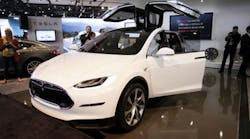Tesla’s first sport utility vehicle is about three months from hitting the market, and the company is preparing for a limited release of an autopilot driving system, Elon Musk, the company’s garrulous CEO, announced at the June 9 shareholders meeting.
The autopilot, which is in the testing stages, would allow drivers to operate a car hands-free on the highway, but with eyes actively on the road, much like a plane’s autopilot. Equipped with forward radar, a forward camera, and 360-degree ultrasonics that reach about 16 feet around the car, it would also allow drivers to auto-park and summon the car on private property.
“I’m testing the latest version every week,” Musk said. “I typically have two or three builds per week that I’m testing in my car. We’re making gradual progress toward what I’d say is a releasable bit of software. But it is quite a tricky thing. and we want to make sure that our testing is exhaustive before we release the software.”
If all goes well, Musk said, Tesla’s autopilot will rolled out to its small group of limited access customers, “which is sort of our public beta program,” by the end of June. The hope is that Tesla will introduce a fully driverless car in three years, for someone to “actually literally go to sleep and wake up at their destination,” he said off-handedly. “But this is an extremely difficult engineering process. I think probably we’d want autopilot to be at least sophistically 10 times safer than a person before we would suggest that someone simply turn on autopilot and wake up at their destination.”
Musk said the company is working on the “final nuances” of the Model X SUV, and expecting its first deliveries in three to four months.
“I am looking at the latest iterations every week,” Musk said. “We want to make sure that some of the key features, particularly the Falcon Wing door and the second-row seats, are done just right. And provide true functionality and value improvements versus just sort of feeling gimmicky."
Musk said the company’s Supercharger network, where users can charge up their vehicles at retro-futuristic-looking charging stations for free, has grown like “kelp on steroids.” Its battery swap experiment, on the other hand, where customers trade a spent battery for a fully charged one at a designated roadside station, has grown more like tortoises on Quaaludes, and will probably not be expanded.



